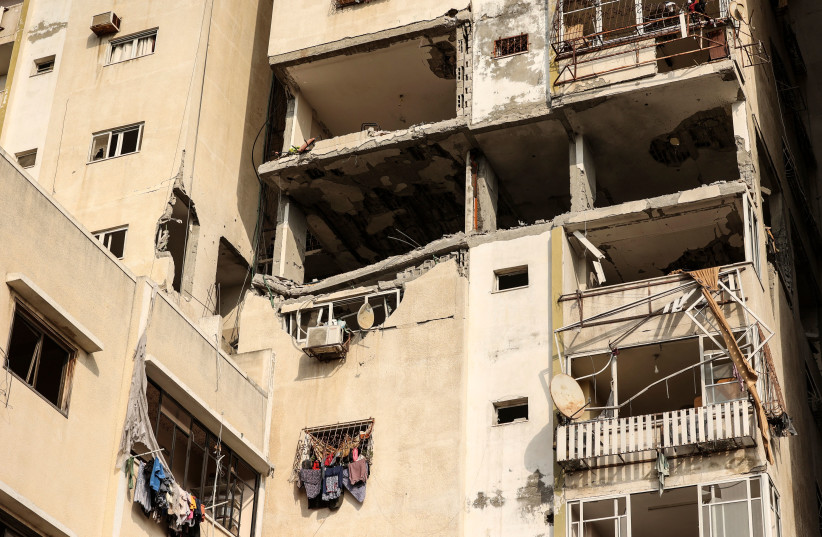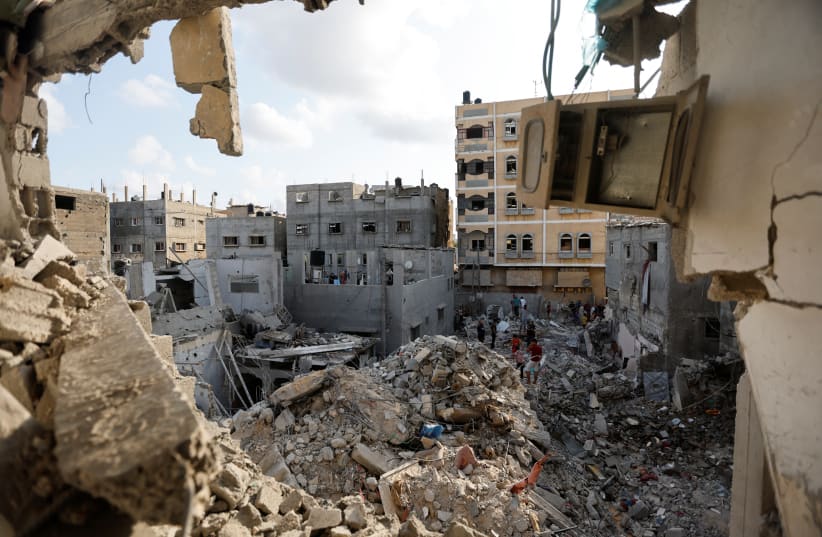At about 9 p.m. on Saturday, an explosion in Jabalya in the Gaza Strip killed, among others, four children.
Joint List MK Ahmed Tibi tweeted photos of three dead boys, with the message, “This is what the US and the UK refer to as ‘Israel’s right to self-defense’: Three or more ‘dangerous terrorists’ killed in Gaza now. Clearly today Israel is a safer place.”
However, as it soon became apparent, the children’s tragic deaths were not at Israel’s hands. One of the hundreds of rockets Palestinian Islamic Jihad launched toward Israelis backfired, falling and exploding in Gaza itself. This time it was fired from a mosque, compounding the war crime of acting from civilian populations onto the war crime of attacking them. Two videos, one from Palestinian sources spread on social media and another grainy, black-and-white one from the IDF, showed what actually took place.
Still, the explosion, like so many other unfortunate occurrences over the years, had the potential to become one that the media and activists would latch onto, with invective about Israel intentionally killing children spreading on social media, and moving up into such claims being made more subtly in the mainstream international press, and then ultimately condemnation by governments. That could turn into pressure on Jerusalem to wrap up the operation, whether it was really ready to do so or not.
But what really happened was the opposite of the bleak scenario that Israelis have come to expect.


By the middle of the next day, Tibi deleted his tweet.
The headline in Germany’s Bild newspaper on Sunday morning read, “Palestinian missile kills civilians in Gaza: Terror bullets explode on their own territory.”
Outside of the Arab world – and in some cases, inside it – other media didn’t focus on the deaths in Jabalya.
Three paragraphs into its article headlined “Gaza escalation continues into second day,” CNN noted that, “In one incident Saturday, four children were among seven people killed in an explosion in Jabalya. The Palestinian Health Ministry initially said the blast was caused by an Israeli airstrike. Israel rejected the claim and said it was the result of errant rocket fire, and released a video showing what it said was the Islamic Jihad rocket sharply changing course in the air and hitting the building.”
Major news agencies like Agence France-Press, the Associated Press and Reuters reported what happened in a similar manner.
In another example, the Abu Dhabi-based English-language outlet The National wrote about midway through its article on the violence in the coastal enclave that “Gaza’s health authorities said six children were among 32 people killed so far in the Israeli strikes.... Israel said it had ‘irrefutable’ evidence that some of the children were killed when a rocket fired by Islamic Jihad landed in the Jabalya area in northern Gaza on Saturday. The military shared a video on its Twitter [account] that appeared to show a rocket falling to earth shortly after launch.”
The article featured the IDF tweet with the video.
How did this quick turnaround happen?
How did this quick turnaround happen? Though many of Israel’s supporters lament Jerusalem’s poor public relations efforts, this was an occasion where the system actually worked.
“We identified the potential for damage from this incident very quickly,” Public Diplomacy Directorate head Lior Haiat said on Sunday. “We understood it could be a public diplomacy catastrophe that could lead to diplomatic harm, which could change the direction of the campaign.”
Within minutes, Haiat, IDF Spokesperson Brig.-Gen. Ran Kohav and representatives of the Shin Bet (Israel Security Agency), the Prime Minister’s Office and Foreign Ministry discussed the incident. Defense officials were quickly able to determine not only that the IDF was not responsible, but that Islamic Jihad very clearly was.
Haiat was able to coordinate a media plan with the others within an hour. He released a statement that said Israel had “in our possession videos that prove beyond a shadow of a doubt that this incident was not the result of an Israel Defense Forces’ strike. Israeli security forces did not strike in Jabalya in the past few hours.
“It has been irrefutably proven that this incident was the result of the misfiring of a rocket launched by Islamic Jihad,” he stated. “Following reports in Palestinian and international media, an investigation took place which unequivocally showed that this was not an Israeli strike but rather, a rocket launched from within the Gaza Strip which fell in the heart of Jabalya. All fire by the Islamic Jihad terrorist organization is a double war crime: it is shooting at civilians, and using Gazan civilians as human shields,” he said.
“It has been irrefutably proven that this incident was the result of the misfiring of a rocket launched by Islamic Jihad.”
Lior Haiat
“This incident is an example of Islamic Jihad harming the residents of Gaza. All harm to innocent civilians is tragic,” the statement concludes.
Haiat’s statement was translated into multiple languages and sent to Israeli embassies around the world, which quickly passed on the message to local media.
International spokeswoman for Prime Minister Yair Lapid Keren Hajioff sent a video of herself making a similar statement that could be used for television and social media.
The IDF released its own statement about its “in-depth debrief,” including that it “did not conduct any activities in Jabalya at the time of the event.”
At the same time, Lapid released Culture and Sport Minister Chili Tropper from an ongoing Security Cabinet meeting to speak to Israeli media in the name of the government.
The wartime event that probably most hurt Israel’s efforts during Operation Guardian of the Walls last year was the bombing of the al-Jalaa building, where the Associated Press had its Gaza offices. The IDF said it struck the site because Hamas had equipment in the building that was jamming the Iron Dome missile-defense system’s signals. The strike sparked criticism of Israel around the world, including from Washington. Maj.-Gen. Nitzan Alon, who probed the IDF’s PR issues after the operation called it an “own goal.”
One advantage Jerusalem had this time is that it is clear Israel didn’t actually bomb the building with children inside in Jabalya, and there were images and videos backing up the denial. That is an easier story to tell than “we did it, but here’s why it wasn’t bad.”
“Past experience taught us that an event like this can disrupt a campaign,” according to Haiat, who is a veteran diplomat and was the spokesman for the Foreign Ministry during Operation Guardian of the Walls last year.
As such, each party involved in speaking for Israel took action “very, very quickly,” he said, because “all the factors in the system understood the potential” for damage.
